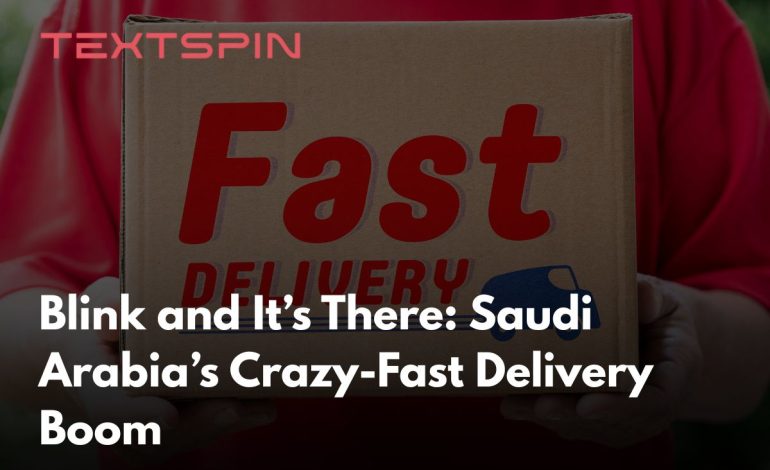
Blink and It’s There: Saudi Arabia’s Crazy-Fast Delivery Boom
Wait, Ten Minutes? Seriously?
Picture this: You tap “checkout” on a grocery app, wander to the kitchen to grab a glass of water, and by the time you are back, your groceries are already pulling up outside. Sounds like sci-fi, right? Not in Saudi Arabia. Shoppers in Riyadh, Jeddah, and Dammam are seeing doorstep drop-offs in ten, sometimes even five, minutes. In a world where most of us feel fancy when we snag same-day shipping, the Kingdom just rewrote the delivery playbook, and they did it at ludicrous speed.
The Perfect Storm Behind the Speed
How did Saudi Arabia go from two-day to two-song delivery? Three things line up just right.
- A youth-powered mobile nation
Roughly two-thirds of Saudis are under 35, and they live on their phones. Social apps double as shopping malls, so clicking “buy now” happens as casually as sending a meme. - Deep pockets and big goals
Vision 2030 is not just a buzz phrase. Billions of dollars are flowing into logistics highways, smart warehouses, and yes, fleets of electric scooters. When the government wants speed, suppliers sprint. - Compact urban hot spots
Riyadh’s dense neighborhoods are perfect for micro-hubs. A quick scooter ride can cover thousands of hungry households in one tiny radius.
Put those together and you get a delivery ecosystem that feels less like a courier network and more like teleportation.
Micro-Hubs: The Tiny Warehouses Making It Happen
You have heard of dark stores, but Saudi operators have gone micro. Imagine walk-in coolers meets vending machine meets bat cave. We are talking 1,500 to 3,000 square feet packed floor to ceiling with the top five percent of items people order on repeat: eggs, energy drinks, phone chargers, those spicy chips you swear you will quit next week. Inventory turns over so fast you can practically hear the shelves whoosh.
Each hub plugs into real-time demand data. When the lunch rush starts, the system autopings the nearest supplier to top up falafel wraps or bottled cold brew. No employee is eyeballing a clipboard; algorithms do the thinking and robots do the heavy lifting.
Meet the Delivery Swarm: Scooters, Bikes, and the Occasional Skateboard
The last mile in Saudi Arabia is more like the last 800 meters. Gig riders on electric bikes zip down service lanes, cutting through traffic via side streets only locals know. The dispatch app is a gamified leaderboard. Complete a run under six minutes? You jump spots on the ranking and snag a bonus. Couriers chase those bonuses like gamers chasing XP, and customers ride the reward wave.
Three separate apps might be battling for the same order, pushing times lower. If the nearest driver is 90 seconds away, another platform tries to beat that by finding someone 60 seconds out. The result: hyper-competition that keeps everyone honest … and crazy fast.
Data Is the Real Engine
Under the hood, Saudi delivery giants crunch enough data to make Wall Street jealous. They ingest:
- Social chatter (is a K-pop band trending, spiking energy-drink sales?)
- Real-time weather (sandstorm rolling in, brace for bottled water demand)
- Prayer times (traffic dips, perfect moment to push hot food)
- Soccer fixtures (snack delivery spikes at halftime)
Every data point tweaks stock levels, reroutes scooters, and updates the ETA you see on your phone. That two-minute adjustment might sound small, but shave two minutes off a thousand orders and you gain hours of driver capacity.
What This Means for North American Shoppers (and Retailers)
If you are sitting in Toronto wondering, “Cool story, but when do I get my ice cream in ten minutes?” brace yourself. Saudi Arabia’s model will ripple out. Here is why:
- Consumer expectations are contagious. Once any market proves double-digit-minute delivery is possible, TikToks and tweets spread the hype. Shoppers everywhere start asking, “Why not us?”
- Tech stacks are portable. AI routing engines, micro-fulfillment software, and electric scooter fleets can launch in any city with decent density.
- Competition never sleeps. The first retailer in your town to adopt micro-hubs wins mindshare. Others must match or watch loyalty vanish.
For small businesses, this is both scary and exciting. You cannot out-Prime Amazon on scale, but you might out-zip them on local speed if you team up with the right courier platform or host a nano-hub in your back room.
Three Cheat Codes for Local Merchants Who Want In
1. Partner With a Micro-Fulfillment Network
You do not need to build your own dark store. Companies now lease shelf space in shared hubs. You drop off inventory in the morning, and they handle picking, packing, and dispatch.
2. Curate a Speed-Friendly SKU List
Not every product needs one-digit delivery. Focus on items people want right now: snacks, party supplies, pet emergencies, phone accessories. Lower variety, faster turnover.
3. Lean Into Hyperlocal Marketing
Highlight speed in your ads. “Order dog treats, fetch in ten.” It sounds gimmicky until a neighbor actually tests it and tweets the timestamped receipt.
Will It Stick? The Sustainability Question
Critics point to van congestion and carbon output. Saudi operators counter with some solid steps:
- Electric fleets: Many scooters and vans already run on batteries.
- Batch routing: Software pairs multiple orders in one run, cutting empty miles.
- Return loops: Drivers handle pickups and recycling on the way back, filling previously dead time.
Is it carbon-neutral yet? No. Is it greener than three separate car trips to the store? Likely. As EV costs fall, speed and sustainability can coexist.
Peeking Around the Corner: Five Trends to Track
| Trend | Why It Matters |
| Drone-friendly corridors | Sky routes slice through traffic and desert stretches. |
| Predictive shopping | The app packs your cart before you open it, based on past cravings. |
| Smart lockers at apartments | Couriers drop once, multiple residents grab on demand. |
| Instant returns | Bought the wrong size? A rider collects it in 15 minutes. |
| Real-time carbon badges | Apps show emissions per order to nudge greener choices. |
Chances are you will see at least two of these pop up in your city within three years. When they do, thank (or blame) Saudi Arabia for the preview.
Final Thoughts: Blink and You Miss the Future
We used to brag about next-day delivery. Now the Kingdom of Saudi Arabia treats ten minutes like yesterday’s news. The lesson for the rest of us is crystal: speed is not a luxury, it is the next price-of-entry. Whether you are a global retailer or a corner shop slinging midnight snacks, your ETA is about to become your brand. So gear up, plug in, and maybe keep an eye on your porch … that new charging cable you ordered might arrive before you finish this sentence.





